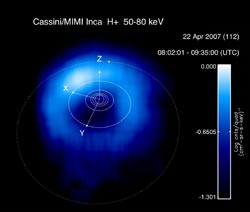Saturn's skewed ring current

MIMI image showing the energetic neutral atom emission from Saturn’s ring current as the energetic ions charge exchange with the dense water products neutral cloud surrounding Saturn. The pronounced asymmetry (bright emission in the upper left quadrant, located between noon and dawn) rotates with the planet, and the bright spot will appear 180° away approximately 5..5 hours later.
Dr Stamatios “Tom” Krimigis, the Principal Investigator for the instrument, who is presenting images at the European Planetary Science Congress in Potsdam on Thursday 23rd August, said, “Ring currents surround planets sort of like the brim of a hat. Uniquely in Saturn’s case, that brim has been crushed at the front and tipped up at the back, so it’s pretty bent out of shape!”
The presence of a ring current around Saturn was first suggested in the early 1980s following magnetic anomalies observed by the Pioneer 11 and Voyager 1 and 2 spacecraft. Ring currents are also found around Earth and Jupiter. They are caused when plasma becomes trapped between mirror points on magnetic field lines, similar to the Van Allen radiation belts surrounding Earth, and gradually drifts around the planet. The aggregate motion of all of the hot ions distributed around the equator generates an electric current. On Saturn, the source of the plasma is material from the rings and gas vented by geysers on the moon Enceladus, which is subsequently ionized and accelerated. The MIMI images show that the ring current occupies a region of the equatorial plane between 540 000 kilometres and 1 080 000 kilometres from the centre of Saturn. They also show that Saturn’s ring current is persistently asymmetric (unlike Earth’s), and that the asymmetry rotates nearly rigidly with Saturn.
MIMI, which was developed by an international team led by the Johns Hopkins University Applied Physics Laboratory (APL), Laurel, Maryland, has three distinct sensors that allow it to “visualize the invisible” and show the plasma and radiation belts in Saturn’s environment in an image. The MIMI instrument includes an Ion and Neutral Camera developed by APL, a spectrometer built by the University of Maryland, and a low energy particle detector developed by the Max-Planck-Institut fuer Sonnensystemforschung and a number of co-investigator institutions including CESR in Toulouse.
Media Contact
All latest news from the category: Physics and Astronomy
This area deals with the fundamental laws and building blocks of nature and how they interact, the properties and the behavior of matter, and research into space and time and their structures.
innovations-report provides in-depth reports and articles on subjects such as astrophysics, laser technologies, nuclear, quantum, particle and solid-state physics, nanotechnologies, planetary research and findings (Mars, Venus) and developments related to the Hubble Telescope.
Newest articles

High-energy-density aqueous battery based on halogen multi-electron transfer
Traditional non-aqueous lithium-ion batteries have a high energy density, but their safety is compromised due to the flammable organic electrolytes they utilize. Aqueous batteries use water as the solvent for…

First-ever combined heart pump and pig kidney transplant
…gives new hope to patient with terminal illness. Surgeons at NYU Langone Health performed the first-ever combined mechanical heart pump and gene-edited pig kidney transplant surgery in a 54-year-old woman…

Biophysics: Testing how well biomarkers work
LMU researchers have developed a method to determine how reliably target proteins can be labeled using super-resolution fluorescence microscopy. Modern microscopy techniques make it possible to examine the inner workings…





















